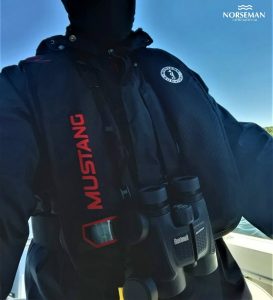PFDs are for safety –Just Wear It!

It was a tick past 0500 when we conducted this morning’s boating lesson. This particular client happened to be new to boating, knew nothing about her new 40’ center console, and needed to start from the basics. So as always, I laid out the cold hard question of whether or not they’ve known anyone who’s passed away from a boating incident – the answer was a hesitant but thankful, “No.”
All too often in our day to day lives we are accustomed to doing things on autopilot. We get so used to when, what, and how we do things that they ultimately become second nature. And that was the point that I wanted to drive home with that question – making PFD’s (Personal Floatation Devices) second nature for everyone on board is a must. Plus, with all the confusion that can be going on around us as well as on board our vessel, a PDF is the last thing we want to find ourselves scrambling for.
Fast forward to this 2022 boating season, which will undoubtedly see many more boaters enjoying themselves out there on the water, it’s important to keep your wits about you and not get too complacent. You’re in a dynamic environment where everything around you is constantly moving and so it’s very easy to see how mishaps can suddenly and unexpectedly happen. You need to be ready BEFORE anything happens.
The same thing goes with running aground or hitting something. Now touch your thumb to your forefinger, as if to say “okay” – that approximate size diameter hole will let in an average of 66 gallons of water a minute – enough to sink a vessel within a minute and a half – fact. And considering that most people who hit something (aside from running aground), aren’t even aware of it until it’s too late, are in shock from the situation and “sink under pressure” without donning the one thing that can increase survival rates in these types of situations – their PFD.
Of the classes of PFD’s, the US Coast Guard law requires a TYPE I – Offshore Buoyant (the big bulky orange ones) for all passengers on board. These are designed for when you’re boating in an environment where help may not be immediate. Boaters generally know these as they satisfy the USCG law when getting pulled over however, the reality is that not many adults want to be seen riding around with one on.
The TYPE II – Near-Shore Buoyant, designed for faster rescue, are also for serious inland and near shore cruising. Although not guaranteed to turn all unconscious wearers face-up as are the TYPE I’s, these PFDs have since become the go-to for boating enthusiast who want to be practically safe (aka wearing their PFD) while boating. In addition, alternative versions also come in a hydrostatic option whereas the PFD will deploy when submerged in a certain amount of water – typically 4 or more inches. These vests are low profile, more aesthetically trendy, and all major PFD companies offer them now a days.
In the end, do your own homework about which PFD will be best for you – Think Safe and choose the Right PFD for you!
